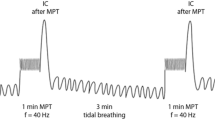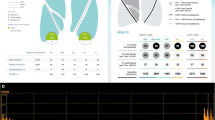Abstract
Introduction
To evaluate the cardio-pulmonary hemodynamics changes before and after valve treatment, and their correlation with lobe volume reduction.
Methods
This retrospective multicentre study included consecutive patients undergoing bronchoscopic valve treatment for heterogeneous emphysema. In addition to standard functional evaluation, patients underwent cardiac evaluation by Doppler trans-thoracic echocardiography. The difference in respiratory and cardio-pulmonary hemodynamics indexes before and 3-month after the procedure, and their relationship with changes in lobar volume were evaluated.
Results
Seventy-seven patients were included in the study; of these 13 (17%) presented pulmonary hypertension. Only patients with target lobar volume reduction ≥ 563 mL (n = 50) presented a significant improvement of forced expiratory volume in one second, residual volume, 6 min-walk test, and St. George’s Respiratory Questionnaire score; a significant reduction of pulmonary artery pressure, and an improvement of left and right ventricle end-systolic volume; of left and right ventricle end-diastolic volume, and of left and right ventricle stroke volume. The change in residual volume was significantly correlated with changes in forced expiratory volume in one second (r = 0.68; p < 0.001); in 6 min-walk test (r = 0.71; p < 0.001); in St. George’s Respiratory Questionnaire (r = 0.54; p < 0.001); in pulmonary artery pressure (r = 0.39; p = 0.001), in left (r = 0.28; p = 0.01) and right (r = 0.33; p = 0.002) ventricle end-systolic volume, in left (r = − 0.29; p = 0.008) and right (r = − 0.34; p = 0.007) end-diastolic volume, and in left (r = − 0.76; p = 0.009) and right (r = − 0.718; p = 0.001) ventricle stroke volume.
Conclusion
Bronchoscopic valve treatment seemed to have positive effects on cardio-pulmonary hemodynamics, and these changes were correlated with reductions of lobar volume.



Similar content being viewed by others
References
Fiorelli A, D'Andrilli A, Anile M et al (2016) Sequential bilateral bronchoscopic lung volume reduction with one-way valves for heterogeneous emphysema. Ann Thorac Surg 102:287–294
Sciurba FC, Ernst A, Herth FJ et al (2010) VENT study research group: a randomized study of endobronchial valves for advanced emphysema. N Engl J Med 363:1233–1244
Herth FJ, Noppen M, Valipour A et al (2012) International VENT study group: efficacy predictors of lung volume reduction with Zephyr valves in a European cohort. Eur Respir J 39:1334–1342
Klooster K, Hacken NH, Hartman JE et al (2015) Endobronchial valves for emphysema without interlobar collateral ventilation. N Engl J Med 373:2325–2335
Davey C, Zoumot Z, Jordan S et al (2015) Bronchoscopic lung volume reduction with endobronchial valves for patients with heterogeneous emphysema and intact interlobar fissures (the BeLieVeR-HIFi study): a randomised controlled trial. Lancet 386:1066–1073
Kemp SV, Slebos DJ, Kirk A et al (2017) TRANSFORM study team: a multicenter randomized controlled trial of zephyr endobronchial valve treatment in heterogeneous emphysema (TRANSFORM). Am J RespirCrit Care Med 196:1535–1543
Skowasch D, Fertl A, Schwick B et al (2016) LIVE study investigators: a long-term follow-up investigation of endobronchial valves in emphysema (the live study): study protocol and six-month interim analysis results of a prospective five-year observational study. Respiration 92:118–126
Bach DS, Curtis JL, Christensen PJ et al (1998) Preoperative echocardiographic evaluation of patients referred for lung volume reduction surgery. Chest 114:972–980
Watz H, Waschki B, Meyer T et al (2010) Decreasing cardiac chamber sizes and associated heart dysfunction in COPD: role of hyperinflation. Chest 138:32–38
Fiorelli A, Poggi C, Anile M et al (2019) Visual analysis versus quantitative CT analysis of interlobar fissure integrity in selecting emphysematous patients for endobronchial valve treatment. Interact Cardiovasc Thorac Surg 28(5):751–759
Fiorelli A, Santini M, Shah P (2018) When can computed tomography-fissure analysis replace Chartis collateral ventilation assessment in the prediction of patients with emphysema who might benefit from endobronchial valve therapy? Interact CardiovascThorac Surg 26:313–318
Laszlo G (2006) Standardization of lung function testing: helpful guidance from the ATS/ERS Task Force. Thorax 61:744–746
Welling JBA, Hartman JE, van Rikxoort EM et al (2018) Minimal important difference of target lobar volume reduction after endobronchial valve treatment for emphysema. Respirology 23(3):306–310
Spencer KT, Kimura BJ, Korcarz CE et al (2013) Focused cardiac ultrasound: recommendations from the American Society of Echocardiography. J Am Soc Echocardiogr 26:567–581
Hoeper MM, Bogaard HJ, Condliffe R et al (2013) Definitions and diagnosis of pulmonary hypertension. J Am Coll Cardiol 62:D42–50
Fiorelli A, Petrillo M, Vicidomini G et al (2014) Quantitative assessment of emphysematous parenchyma using multidetector-row computed tomography in patients scheduled for endobronchial treatment with one-way valves. Interact Cardiovasc Thorac Surg 19:246–255
Eberhardt R, Gerovasili V, Kontogianni K et al (2015) Endoscopic lung volume reduction with endobronchial valves in patients with severe emphysema and established pulmonary hypertension. Respiration 89:41–48
Pizarro C, Schueler R, Hammerstingl C et al (2015) Impact of endoscopic lung volume reduction on right ventricular myocardial function. PLoS ONE 10:e0121377
Gagnon P, Guenette JA, Langer D et al (2014) Pathogenesis of hyperinflation in chronic obstructive pulmonary disease. Int J Chron Obstruct Pulmon Dis 9:187–201
Oswald-Mammosser M, Kessler R, Massard G et al (1998) Effect of lung volume reduction surgery on gas exchange and pulmonary hemodynamics at rest and during exercise. Am J RespirCrit Care Med 158:1020–1025
Caviezel C, Aruldas C, Franzen D et al (2018) Lung volume reduction surgery in selected patients with emphysema and pulmonary hypertension. Eur J Cardiothorac Surg 54:565–571
Barr RG, Bluemke DA, Ahmed FS et al (2010) Percent emphysema, airflow obstruction, and impaired left ventricular filling. N Engl J Med 362:217–227
Jörgensen K, Houltz E, Westfelt U et al (2003) Effects of lung volume reduction surgery on left ventricular diastolic filling and dimensions in patients with severe emphysema. Chest 124:1863–1870
Author information
Authors and Affiliations
Corresponding author
Ethics declarations
Conflict of interest
Alfonso Fiorelli, Roberto Cascone, Giovanni Natale, Valentina Peritore, Camilla Vanni, Camilla Poggi, Federico Venuta, Erino Angelo Rendina, Mario Santini, and Claudio Andreetti disclose no conflict of interest and no funding for the present paper.
Additional information
Publisher's Note
Springer Nature remains neutral with regard to jurisdictional claims in published maps and institutional affiliations.
Rights and permissions
About this article
Cite this article
Fiorelli, A., Cascone, R., Natale, G. et al. Cardio-Pulmonary Changes After Bronchoscopic Lung Volume Reduction with Endobronchial One-Way Valves. Lung 198, 565–573 (2020). https://doi.org/10.1007/s00408-020-00351-4
Received:
Accepted:
Published:
Issue Date:
DOI: https://doi.org/10.1007/s00408-020-00351-4




